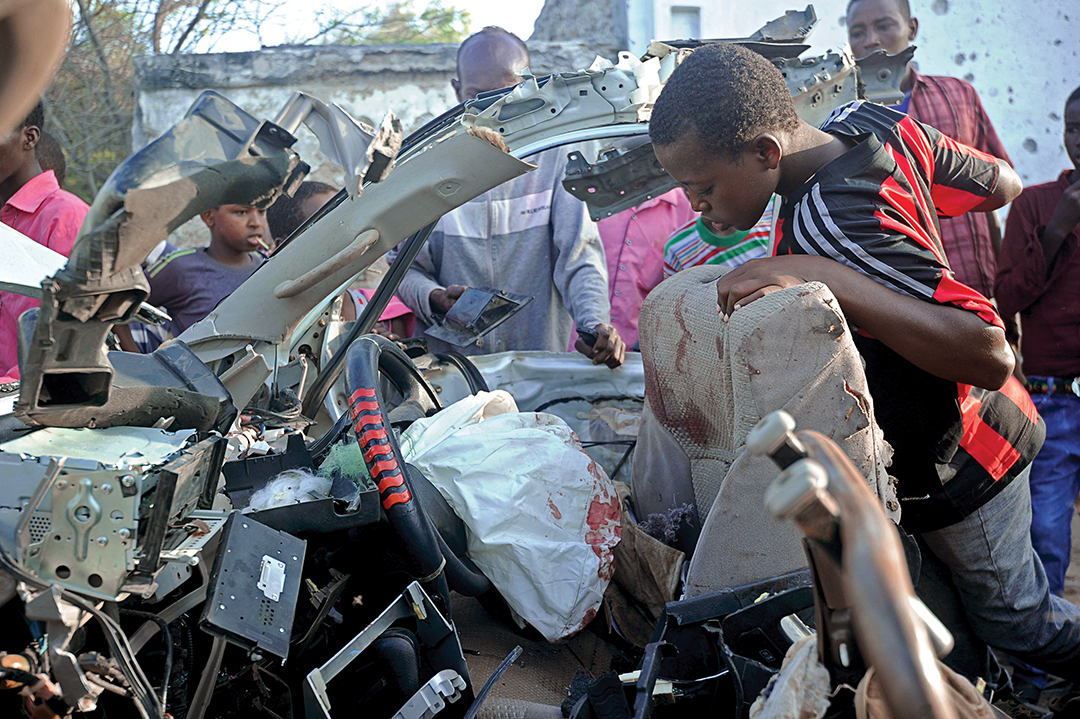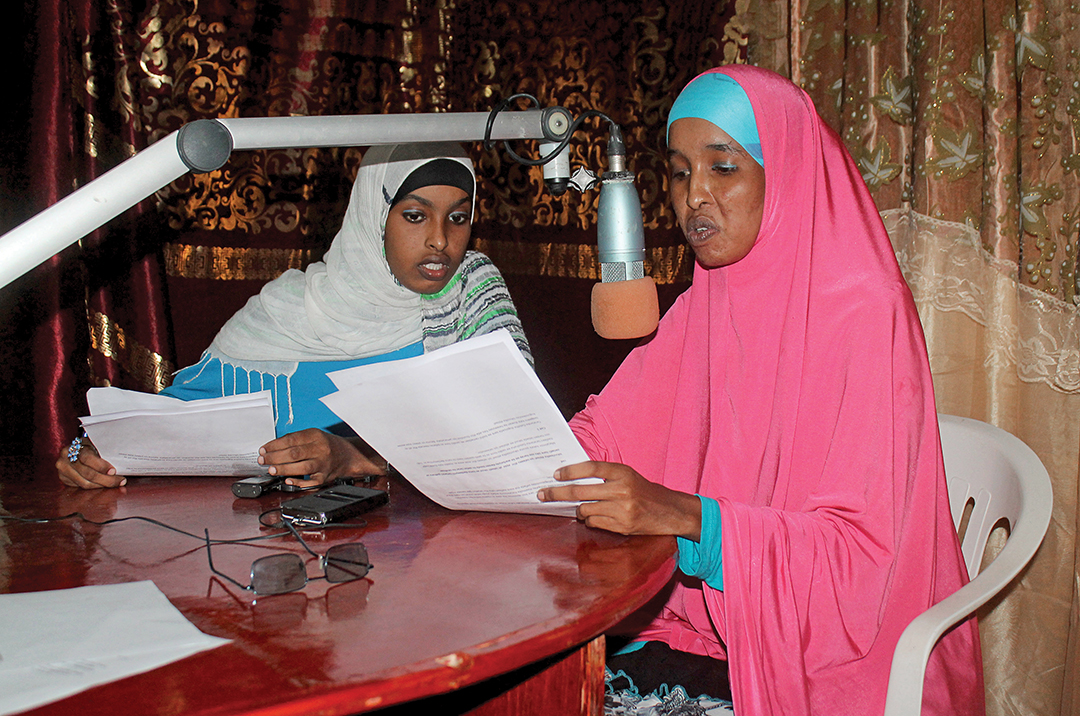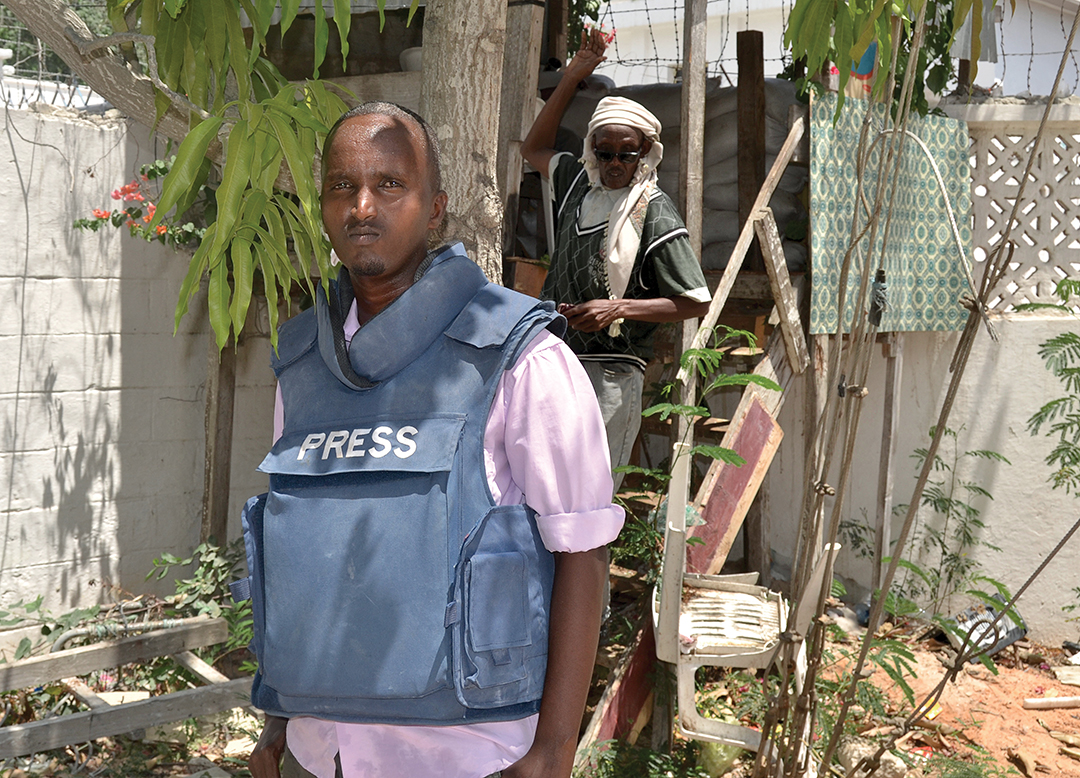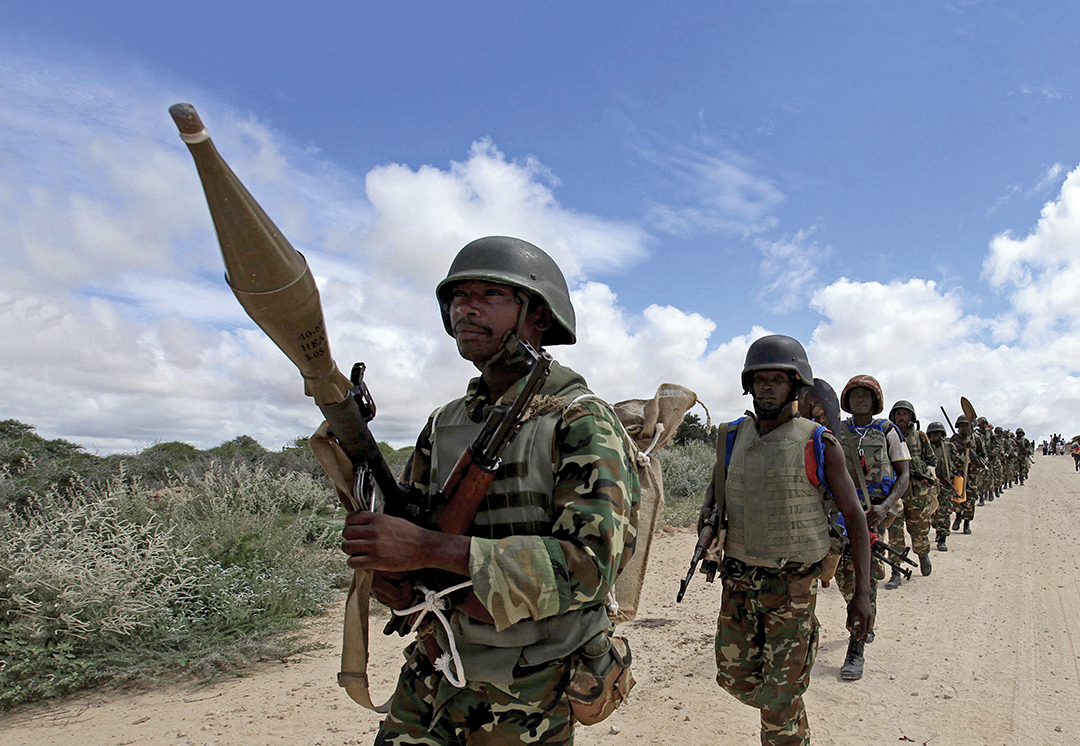FM radio is a potent weapon against extremist propaganda in Somalia
By John Hutchings
In today’s high-tech environment, social media and digital communications are ubiquitous in almost every sector of society, culture, business and government. Countering violent extremism (CVE) is no different; social media and digital reach enhance the strategic communications elements of CVE. However, the old-fashioned medium of radio maintains many advantages, especially in less developed regions. FM radio can play an important role in a multidimensional, coordinated approach that corresponds with a target audience and uses a combination of digital and analogue.
Radio in Somalia
Radio is on the rise in Somalia. It is far-reaching and technologically easy to start up. It has been used in the past to push narratives relating to the long-running conflict — including efforts both in favor of and, vexingly, in opposition to peace. Radio is a tool available to counterterrorism practitioners, particularly in Somalia where it is important to counter the narrative of the extremely violent dissident group al-Shabab (AS).
AS has become more sophisticated in its strategic communications at the same time the internet has become more prevalent. However, the internet does not have widespread reach or penetration in Somalia. A 2015 survey by the British Broadcasting Corp. (BBC) found that although there is widespread availability of cyber cafes and internet-enabled devices, the high cost of accessing the internet, combined with underdeveloped infrastructure, means using it is beyond the reach of most Somalis.

In this context, radio remains the best vehicle for communicating narratives and counternarratives to the general public. It is also important to understand that Somalia is one of the most culturally homogenous nations in the world. The Somali people speak one language (Somali) and nearly all of them are Sunni Muslims. These factors facilitate programming based on a narrative that Somalis can commonly identify with. If the impartiality and integrity of radio are sustained, it becomes a trusted medium and can function as a building block of a civil democratic society that stays true to its ideological, religious and homogenous identity.
Radio has been part of a counternarrative program used by United Nations and African Union Mission in Somalia (AMISOM) troops to take on AS since 2009, when the first U.N.-funded public broadcast service began transmitting from Mogadishu. Mogadishu was then a city divided — government forces and AMISOM troops controlled one part and AS another. As AMISOM took ground from AS, radio flourished. Radio is prolific in Somalia, and it nestles hand in glove with an inherent culture of storytelling, poetry and music. When the U.N. returned in 2009 after an eight-year hiatus, the effects of the civil war that raged over two decades had led to the denigration of the state and rule of law. Most governance structures had decayed and given way to clan warfare as well as a rise in radical Islamist groups, including the Islamic Courts Union, which spawned AS.
Technological ease
Over the years, AS developed its own media machine and appeared to be ahead of the curve in the media landscape. AS media outlets such as Radio Andulus and AS News Channel still transmit the terrorists’ narrative. AS has a strong technological approach to radio, and there is no doubt that it is adaptive. In the past, the group has captured radio station facilities and used the frequencies and equipment to broadcast its own programs, which is easy and cost effective. Although radio programming can be complex, the basic capability can be easily achieved with a transmitter and rudimentary equipment such as a microphone and basic mixing equipment. This can be an advantage for governments as well as dissidents, but it’s important to recognize this ability and use it for maximum effect. AMISOM seized on this, using the highly mobile “radio-in-a-box” system donated by the U.S. State Department. It moves with AMISOM troops and is being used to some effect in Jowhar, Barawe and Marka, Somalia, by Burundi and Ugandan AMISOM contingents. The station, which transmits in FM and has a 25-kilometer broadcasting range, has programming in Somali and English (English is widely spoken by returning diaspora from Europe and the U.S.). The content includes the impact AMISOM is having in the area, thus contextualizing the “hearts and minds” program, as well as the counternarrative against AS and encouragement for AS members to defect. The content is produced with assistance from the United Nations Assistance Mission in Somalia. This collaborative approach is ideal for CVE, utilizing the journalistic, technical and polished production talents imported from the U.N. combined with local talent on a platform in the target area.

The station airs sports only, no politics. THE ASSOCIATED PRESS
Al-Shabab’s reach
AS not only uses radio to great effect, it also has
reach on the internet to metropolitan areas and the diaspora. However, as highlighted above, the internet does not yet have an extensive saturation in Somalia because of cost, though this could change rapidly as fiber expands available bandwidth and, where there is security, infrastructure grows. Sheikh Abdiasis Abu Musab, AS’ military operations spokesman, produces a prolific narrative and commentary to news agencies. AS’ narrative retains a clear, consistent and simple ideology. AS’ primary goal is to topple the Somali government, rid the country of “foreign invaders”
and establish an Islamic emirate based on a strict interpretation of Sharia. This narrative may not reflect reality, but it is prominent in its messaging, and it can appeal to those with limited perspectives in rural areas and some of the diaspora community. AS has shown simple lines of messaging that resonate with at least some of its target audience, constantly reiterating that the group’s members are Somali, religious and capable of providing security.
One problem with trying to counter the AS narrative is that the group produces high-quality, one-off video products for distribution on the internet through AS’ production facility, al-Kataib. The subjects of the videos include the September 2013 attack on the Westgate Mall in Nairobi, Kenya, and the overrunning of the AMISOM bases at Leego (June 2015), Janaale (September 2015) and El Adde (January 2016). Video and radio programs are produced in Somali, Arabic, Swahili and English, allowing AS to reach beyond Somalia.
Given that AS is prevalent on digital platforms and social media, it is important to understand its motives. One of the main objectives of the digital media campaigns is to appease al-Qaida, with whom AS is aligned. This is at least partially to ensure remote funding for their military operations and recruiting — specifically in Kenya and Tanzania. It is also a tool for inspiring attacks on the Somali government and its East African neighbors.
Understanding the audience
When considering radio as a CVE tool, it is important to understand how it can impact AS recruits and potential recruits. The literacy rate in Somalia is very low, about 25 percent, and as revealed in UNESCO’s “2011 Global Monitoring Report,” most AS core members are largely uneducated. The same report found that most young AS recruits were from very remote areas, unemployed and had no access to the communications infrastructure. Many have no idea of the outside world. Many also attended mosques where the clerics, either willingly or by force, allowed AS recruiters to give speeches citing patriotic hyperbole mixed with religious verse justifying violent jihad and resistance to foreign invaders. Ironically, the speeches often use propaganda espousing the rights of children as well as financial incentives.
Importantly, AS recruits are offered a sense of belonging. Many defectors also cite nationalistic reasons for joining and a desire to rid Somalia of foreign invaders (particularly the Ethiopians, regarded as a natural enemy by many Somalis because of the 1977-78 Ogaden War). Other reasons include vengeance, an ideological belief based on doctrines of violent jihad, and the potential for excitement, social status or marriage. Many were also persuaded by security or protection commitments involving their respective clans.
When developing CVE narratives through radio programming, one must consider what impact the message will have and, if possible, how that impact can be measured. Some of the most impactful describe the realities of family separation and emphasize that the intent of AS leadership is not consistent with what is best for Somalia or for Islam. Also effective is informing AS recruits that they can enter disarmament, demobilization and reintegration programs.

The counternarrative
AS has lost significant ground in recent years, and its loss of a foothold in Mogadishu in 2011 allowed independent radio to steadily expand. However, under the last government there was draconian and counterproductive media regulation. With this in mind, the most trusted stations, as determined by a 2017 U.S. Agency for International Development (USAID) survey, are very much old stalwarts: the BBC and the Voice of America. This may be because they are still viewed as impartial, one asset that invokes trust in many Somalis who are skeptical of government radio.
AS’ retreat has opened the way for more dynamic growth in the limited number of radio stations. For instance, Gool FM, a newer, local station, is privately owned and dedicated exclusively to Somalia’s previously underserved but burgeoning sports culture, which includes the enjoyment of football and basketball, as well as national pride in the sporting achievements of diaspora Somalis such as Mo Farah, the reigning 5,000 meter and 10,000 meter Olympic and world champion. This station was able to flourish only after AMISOM ousted AS from the capital in 2011. With the dismissal of AS, new opportunities to listen openly to radio stations other than AS’ Andulus flourished. This may not be immediately relevant to the CVE model; however, it provided an important avenue away from violent extremism and acted as a conduit for a return to “normality.”
One of the great things about Gool FM — which again is perhaps counterintuitive from a CVE perspective — is that it rarely has politicians on the airwaves. Instead, the station concentrates on the sport of the day and has prizes for guessing the correct football scores. When young people have an emotional, almost tribal attachment to a sport or team, it helps fill the hole that disenfranchisement and unemployment cause, mitigating one of the push factors toward violent extremism. It can also be argued that a sports attachment mitigates pull factors in that one can have a sense of belonging as a supporter of a certain football team. It is impossible to walk the streets of Mogadishu without seeing the football jerseys of English Premier League or Spanish league teams. Gool FM’s relevance is greater because of the limited digital reach. Internet penetration was estimated at 1.6 percent in 2014, according to the International Telecommunication Union and, though this has increased recently, it is still expensive.
Challenges
To win the information war the government must:
Control the narrative: AS has had numerous tactical successes and is very quick to highlight these, while also playing down its losses. The federal government of Somalia tends to be sluggish and quite often off message in its response. This may be due to the lack of experience of its Ministry of Information, but it is also because of a stubborn unwillingness to admit it has been caught off guard by AS. The government’s responses have improved over the past few years, and more statements are being issued — mostly condemning AS attacks, especially after civilian casualties occur. The U.N. and AMISOM have different policies: The U.N. rarely responds to incidences unless it’s supporting a government message, while the AMISOM counternarrative all too often highlights its own shortcomings.
Press restrictions, poor infrastructure, insufficient security and the lack of a strategy and cohesive, dedicated radio content limit radio as a CVE medium in Somalia. There are also issues with what independent radio stations will carry. In recent years, the U.N. has delivered plenty of public service announcements (PSAs) but has had to pay stations to play them. PSA content has ranged from encouraging participation in the electoral process to the role of women in the community and has included messages to AS members encouraging defections and reintegration into society. Many fighters have stated that they felt there was no bridge back to their own community and a normal life. Assurances from society and government that defecting AS fighters will receive fair treatment and be reintegrated to live a normal life have been effective, and surveys by USAID have found that more than half the population supports these measures. Educating and informing society must remain a goal of a CVE-based radio program. If former fighters do not get societal acceptance, they could drift to other groups such as ISIS, now in northern Somalia.

Protect journalists: Journalists are the backbone of radio news; without them the stories would have no real substance. Journalism provides informed comment, which helps listeners challenge some of the misconceptions they may have about governance, assistance from the U.N., AMISOM or the larger world. Journalists in Somalia have to work in very hostile conditions — Somalia was ranked 172 out of 180 in the Reporters Without Borders 2015 World Press Freedom Index. Though Somalia is largely unregulated since the collapse of the Said Barre regime in 1991, most journalists view laws passed in 2014 as prohibitive and draconian. Viewed against a backdrop of extreme violence against journalists — that may or may not be related to extremism — it is clear that journalism in Somalia is dangerous; indeed, it is the most dangerous place in Africa for journalists, making it difficult to get good, impartial news.
Despite these challenges, the level of professionalism of many Somali journalists and their sense of fairness and commitment to impartial, accurate reporting is impressive. The National Union of Somali Journalists’ campaign for fair reporting and transparency has helped to highlight the plight of journalists in the country. Transparency in journalism is key for effective CVE because it engenders trust in the media — and if it also exposes some of the corruption in government, then it tackles some of the issues that can lead to violent extremism.
Expand the digital arena: Infrastructure in Somalia is improving due to many factors, one being the extended peace achieved in certain areas by AMISOM’s kinetic approach to AS, as well as foreign investment in roads, electricity and structures. This new infrastructure will improve the digital footprint. As shown in recent surveys by the BBC and USAID, access to TV is expanding, but mostly for those better off financially and urbanites. Similarly, last year’s World Bank study shows that more Somalis are getting the internet but, as already noted, access remains too expensive for most. Radio has the best reach and remains the best communication asset, other than face-to-face interaction. There is a danger that CVE professionals could become besotted with digital media. Making videos and using Twitter tends to be more appealing than the analogue machinations of producing radio — not least because it is easy to quantify tweets and “likes.” And although mobile phone usage has increased exponentially over the past few years, not all phones can access 3G or 4G digital systems — indeed, 3G and 4G facilities are prohibited by AS in their controlled areas — but nearly all Somalis have access to an FM radio.
CVE messaging will benefit from greater frequency regulation, not just for radio stations but for all media across all spectrums. This allows for fair allocation of frequencies and a certain amount of order. There is a lot of saturation in the radio arena and more diverse, open stations are needed to keep the medium fresh and relevant. Young people are the largest demographic in Somalia and also the most vulnerable to the push and pull of violent extremism. Radio must be regulated, but not suffocated by overzealous and restraining policies.
Conclusion
There is no doubt that radio is one the most vibrant and dynamic mediums for communication in Somalia. CVE practitioners must make better use of this tool for narrative and counternarrative. Imagination is key: Young radio listeners need to be engaged in a way that they are not lectured to, nor barraged with political rhetoric. Regulation with a soft hand is needed and so is a whole-of-government approach. The government, through intelligent regulation, could ensure the diversity of radio and work alongside the U.N. and AMISOM to provide useful content that promotes peace and stability, including a message of acceptance and empathy for those in AS who might defect. Music, poetry and theatre may also be used to communicate an understanding of self and identity, often described as important issues by those who have joined terror groups. One should also look at the successes and try to mirror those. For instance, the positive effect of Gool FM is a valuable learning experience. Inspiring young Somalis to be more like Faisal Jama Aden, who played college basketball in the U.S., may prevent some of them from becoming a soon-forgotten suicide bomber.
Looking to the future, there is no denying that social media is slowly growing in importance and may naturally tie-in with the significance of clan and family in Somali culture. However, for now FM radio is the most appropriate tool for reaching the intended target audience of potential defectors, as well those who may influence defectors, such as family and religious leaders.
Finally, security is needed to ensure that radio broadcasts continue to expand and be heard. Therefore, CVE efforts must work hand in glove with more traditional kinetic counterinsurgency and counterterrorism operations. The go-to tool for CVE differs by country — in Somalia, it is the radio.
So tune in and rock the Kasbah! ο


Comments are closed.